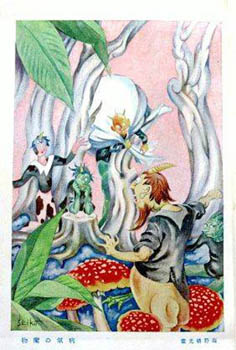
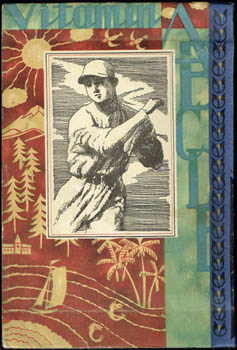
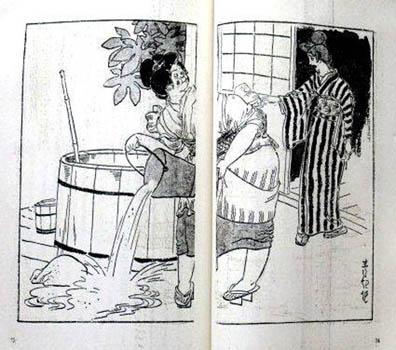

Shogakusei Zenshu. [Kodomo Seiri Eisei Monogatari]. Tokyo, Kobunsha 1928 [Showa 3]. Octavo, cloth backed publisher's illustrated card wrapper; one colour plate, photo and b/w illustrations. Some browning and mild signs of use; a rather good copy. Shogakusei Zenshu no.69. Colour frontispiece by Unno Seiko, other illustrations by Hosokibara Seiki. Au$85
The Shogakusei Zenshu, or Complete Works for Elementary Schools, runs to some 88 volumes of educational texts and literature - much of this in translation; few of them seem elementary. This one covers health. Seiki's illustrations aren't so well printed but they are lively and amusing.
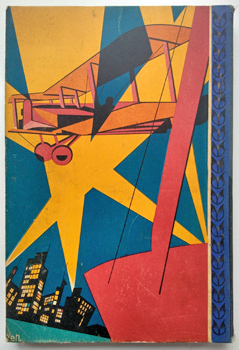
Shogakusei Zenshu. Maekawa Senpan. - [Hikoku no Hanashi - Sensuikan no Hanashi]. Tokyo, Kobunsha 1928 [Showa 3]. Octavo, publisher's cloth backed illustrated card wrapper by Maekawa Senpan; illustrated title, one colour plate, photo and b/w illustrations. Minor signs of use, quite good. Au$135
The Shogakusei Zenshu, or Complete Works for Elementary Schools, runs to some 88 volumes of educational texts and literature - much of this in translation; few of them seem elementary. This one covers the aeroplane and the submarine.
Maekawa started as a cartoonist and became a founding member of the Sosaku Hanga movement. Like many of his generation he continued to make his living as a commercial illustrator. Here he outshines many of his most celebrated prints.
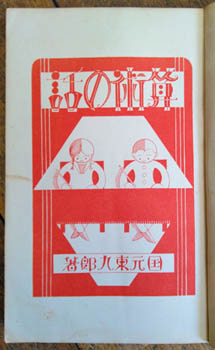
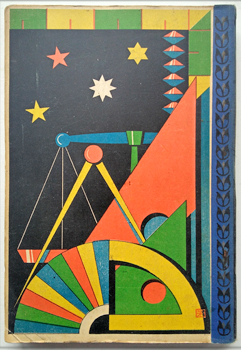

Shogakusei Zenshu. Okano Sakae [cover design]. [Sanjutsu no Hanashi]. Tokyo, Kobunsha 1928 [Showa 3]. Octavo, cloth backed publisher's illustrated card wrapper; illustrated title in red, one colour plate and numerous b/w illustrations and diagrams through the text. Minor signs of use and usual browning; quite good. Shogakusei Zenshu no.73. Au$150
The Shogakusei Zenshu, or Complete Works for Elementary Schools, runs to some 88 volumes of educational texts and literature - much of this in translation; few of them seem elementary. This one is arithmetic. I believe that if my maths texts looked like this my education would have been much more rewarding. This masterpiece of a cover is by Okano Sakae, one of the generation of artists who came through the western painting department of the Tokyo School of Fine Arts at the beginning of the century, later a pupil of Kuroda Seiki, and collaborator with fellow Hakubakai students on the five volume Nihon Meisho Shasei Kiko.
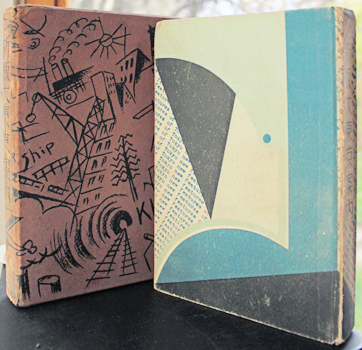
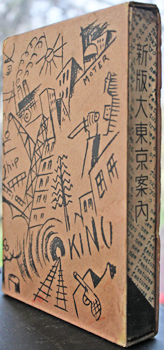

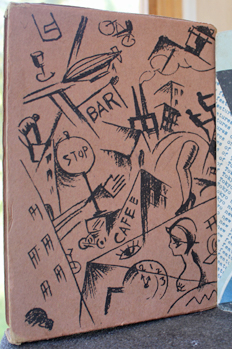

Kon Wajiro. [Shinpan Dai Tokyo Annai]. Tokyo, Chuo Koronsha 1929 (Showa 4). Octavo publisher's illustrated boards and slipcase; 380pp and four double page maps, illustrations throughout, several full page. Inner front hinge cracked, a pretty good copy of a smart but badly put together book. Au$200
First edition of a new guide to a new Tokyo by the founder of Modernology. This is not a guide to carry round, the flimsy construction puts paid to that if you try. Tokyo is divided into culture, purpose and theme more than districts. It comes out of the years spent documenting Tokyo and its people after the 1923 earthquake - what is now called urban ethnology - and work done with other designers and architects shaping the new Tokyo. It is sort of an adjunct and a preface to the Modernologio books to come in the next couple of years.
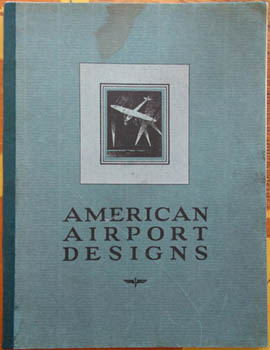
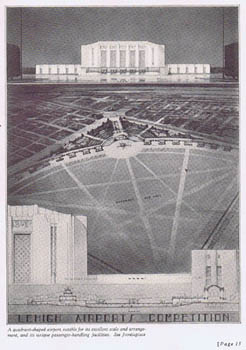
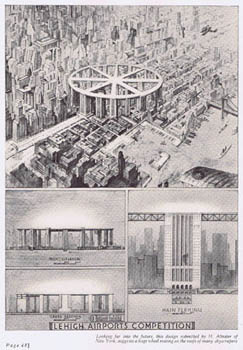

BLACK, Archibald et al. American Airport Designs - containing 44 prize winning and other drawings from the Lehigh Airports Competition ... NY, for the Lehigh Portland Cement Company 1930. Quarto publisher's illustrated heavy wrapper (a stain on the front, later cloth spine); 96pp, mostly plates. A more than decent copy. Au$250
This is, I believe, the first American book on airport architecture, gathering designs submitted to the country's first such competition. The compiler is confident that there are plenty of new ideas never used in Europe and the schemes range from token crackpot visionary - a circular runway running around the tops of skyscrapers - to beaux-arts, with the bulk falling into classical moderne.
Common to all designs chosen for inclusion is a formal layout, with runways, often circular, that range from something like parterre gardens to complex occult symbols; surely evidence that a good beaux-arts education still prevailed. Two designs that have some flashy distinction are by Los Angeles and Florida architects, naturally, with a film set skyscraper and a modernist tower respectively. Both are condemned as unsafe. Maybe interesting now would be tracking down the entries that didn't make the cut - neither Wright's nor Neutra's made the book.
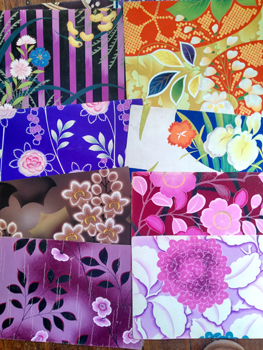
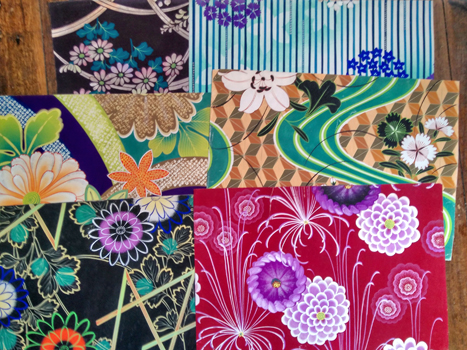
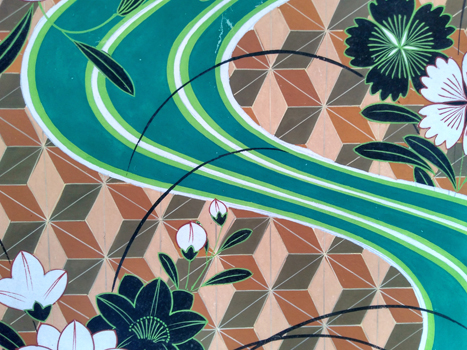
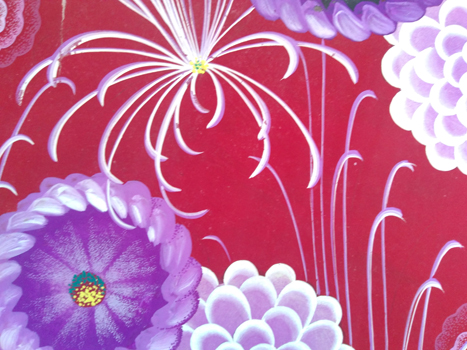

Japanese textiles. A gathering of 15 original designs for textile designs. n.p. [1930s]. 15 sheets in gouche and inks; all about 40cm in one direction and ranging from 20 to 32cm in the other. One with a short clean tear. Short notes on the back of three, numbers on two. Au$650
Pretty lurid, huh? As the thirties pressed on and the avant garde was in disgrace - communist and anarchist scum that they were - textile design became less adventurous in form but brighter, so much brighter, and woodcut pattern books from Kyoto with designs like this proliferated. Something of a Kano school revival.
These flower designs are so highly finished I'm convinced they were made for a pattern book - probably spring or summer; autumn and winter were more restrained. Working drawing are usually much more ... well, working.
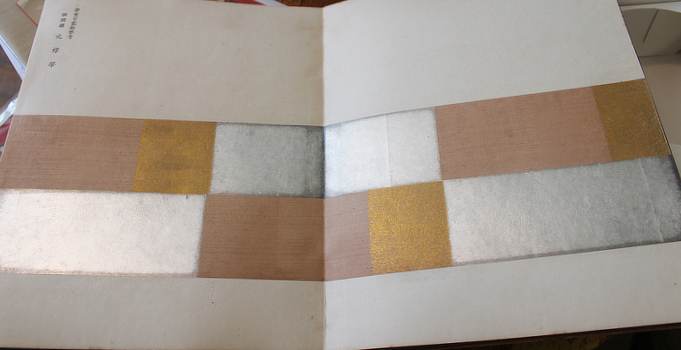
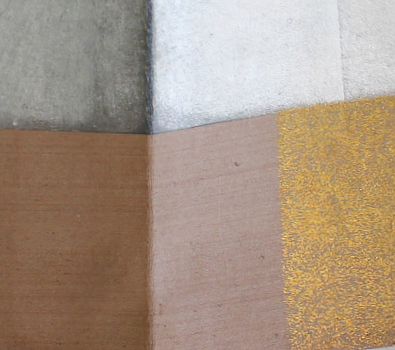
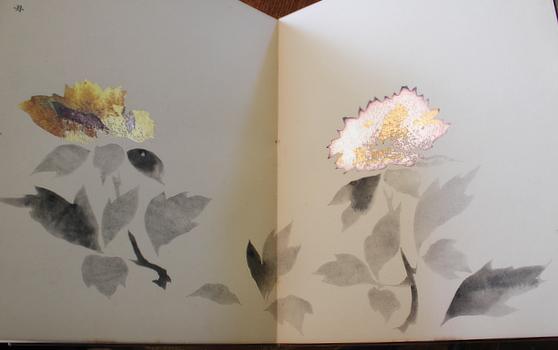
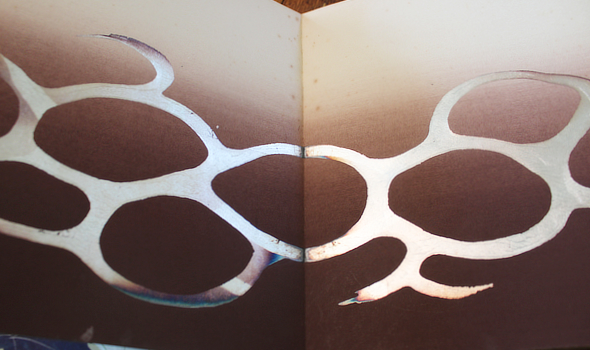

Fusuma design album. [Kimigayo Shirushi Ofusumashu]. n.p. [193-?]. 29x23cm publisher's cloth with paper label; 34 card leaves with colour patterns, mostly double page. At the end are two cloth samples with designs from the album in different colours. One small mounted stripe sample might be missing. Au$600
This is volume six of a series of catalogues cum pattern books of fusuma - paper for sliding screens. Since I can't find a mention of any other copies I have no clue how many there were, nor whether they appeared over a number of years. Kimigayo is the national anthem - the range or the maker's name I don't know.
Fusuma catalogues are usually pretty blah; postwar catalogues should be avoided by all but sturdy cultural archaeologists. Seems makers didn't have a high opinion of the tastes of someone who would buy their screens ready made. This one is the only exception I've seen so far. Some is bland but a lot is high class and chic in the neo-neo-rimpa style, ie the reworking of tasteful luxurious antiquity inspired by the turn of the century work of neo-rimpa designers like Korin, Sekka, Nosaburo et al.
The printing is outstanding and as usual with such stuff, hard to photograph: the aged gold and silver, heavy raised textures, overprinting, embosssing ... need to be seen in the right light. Very Kyoto and far from the brazen tizz of Tokyo and Osaka. Until we find, at the very end, the stamp of the Yamaguchi Hyoguten of Shibuya, Tokyo. Hyoguten usually translates as mounting store - a business that makes scrolls, screens and sliding screens. There are now Yamaguchi Hyoguten everywhere except Shibuya it seems. I don't know whether any of them are related. Still, I insist the desig n and printing belong to Kyoto.
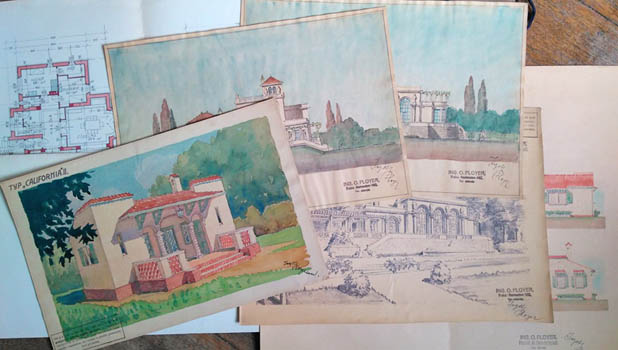
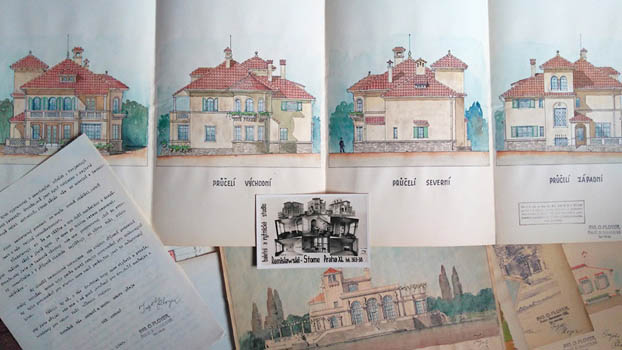

PLOYER, Otokar. Views, elevations and plans for the Remislavsky-Stome villa and studio in Prague, along with drawings and plans for a 'California Weekender'. n.p. c1930-35. Eight sheets ranging in size from single sheets 21x33cm to a four fold sheet 34x83cm. These are printed by whatever lithographic process on a heavy parchment paper and coloured by hand. All have Ployer's stamps and are signed in ink. As well there is a typed signed letter, two pages on one sheet, and a photo collage card printed on the back. Together in a contemporary portfolio, 36x28cm, with ribbon ties. Au$185
The client and the house are easy to track. Dancer, choreographer and former National Theatre Ballet Director Remislav Remislavsky and his ballerina wife Irmou Stome opened their purpose built dance school in 1934. He joined the resistance during war and was denounced as bourgeois and his villa seized in 1948 according to one biographer. He lived happily and taught on after the war according to another. The building survives and appears to be home now to a number of companies that don't actually do anything.
The architect not so much. One drawing here has a blindstamp: "Ing. Otokar Ployer Amer. Architekt" and the photo collage card with the lot is Remislavsky's announcement that the school will open in September 1934 and was purpose designed by American architect "Playerem" (sic). On other drawings he is Ing. O. Ployer. The letter, dated January 1 1936, with the lot explains this group of drawings. He suggests in the letter that his friends might like to build his California weekender. I'd say he added a batch of drawings and plans of the Remislavsky villa - his big project - to impress his prospective clients. He mentions he is working on the design of an air raid shelter, a useful thing to have in central Europe as the thirties progress, and he filed, from Prague, for a US patent for an air raid shelter in 1939 which was granted in 1945. Elsewhere I find the suggestion that he migrated to Sweden at some stage but in 1947 the firm Ployer Otakar of the same address in Prague advertised in a Rio de Janeiro newspaper for contacts with exporters of machinery, rubber, chemicals, coffee, etc and for importers of glass, synthetic stones and toys. 1948 may well have killed that career and seen him off to Sweden. How and where he is an American architect in all this beats me.
The drawings and the photos of the villa built show that a fair amount of rationalisation took place. A grandiose mansion of no fixed heritage is pruned to a large central European Mediterranean villa and built with not a whole lot more trimming down. His California weekender is ... maybe Spanish mission put into a car compactor.
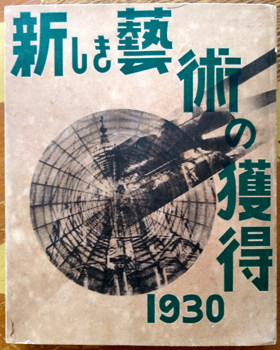
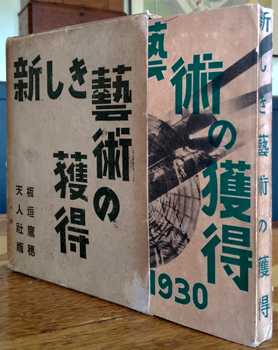
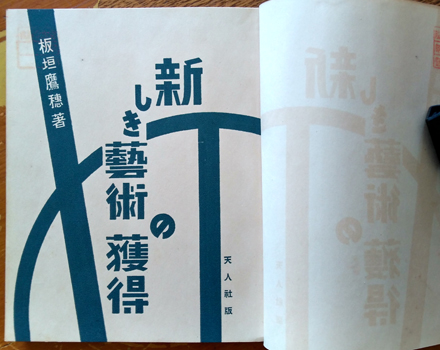
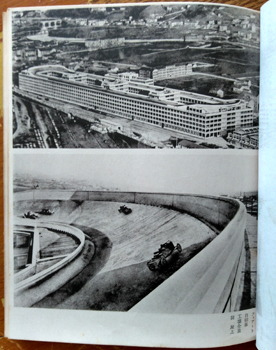

Itagaki Takao. [Atarashiki Geijutsu no Kakutoku]. Tokyo, Tenjinsha 1930. 20x15cm publisher's illustrated wrapper and printed card case; 10,246pp including photo illustrations on 16 plates.Covers mottled as usual with copies that have stayed safe in their box, some browning and minor signs of use; quite good. Au$500
First edition of this essay by the champion of modernism in Japan on the machine and new architecture and design, propounding his concept of "machine realism". This was a theme Itagaki pursued through a few books between 1929 and 1933.
I think the cover shows a locomotive bursting out of some old world construction but it all reminds me of a crashing zeppelin. I can't find a designer's name.
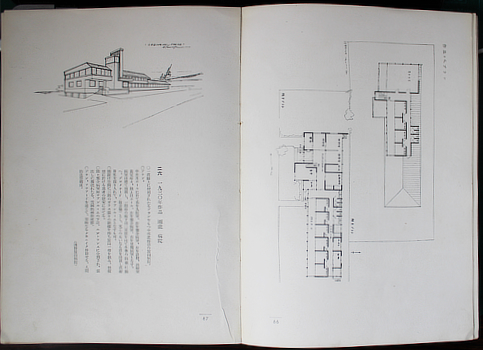
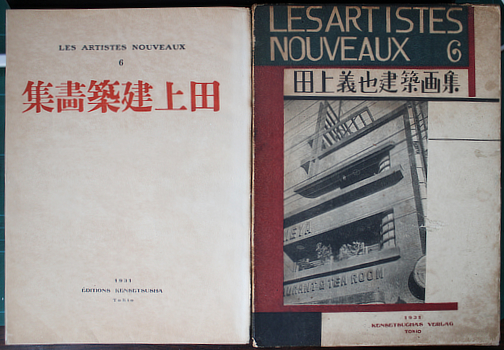
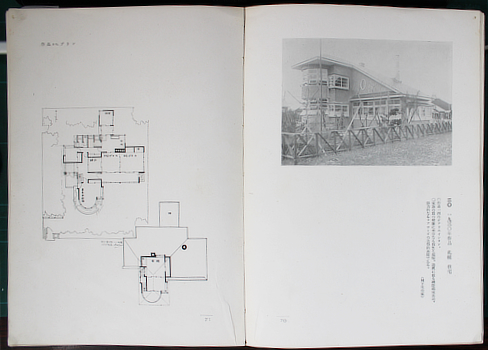
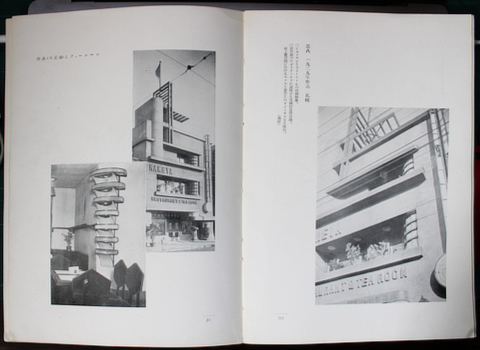

Tanoe [or Tanoue or Tanouye] Yoshiya. [Tanoe Yoshiya Kenchiku Gashu]. Tokyo, Kensetsusha 1931. 27x19cm publisher's printed wrapper, illustrated card slipcase (this marked and a bit worn but solid); 110pp, photo illustrations, renderings and plans. Rather good. Inscribed and signed by Tanoe to artist, later folklorist, and dogged communist Hashiura Yasuo who gets a passing mention in the book. Au$1850
Tanoe began his career working for Wright on the Imperial Hotel - from 1919 to 1923. He then headed off to Hokkaido and is now an architectural hero of the island. The prairie style is evident in some of these early houses but no more than Japan is evident in the prairie style. I read somewhere that for one of the buildings in this book he kept his original plan rather than the compacted plan that was actually built. This was so that his sense of space was preserved.
I think the rest of this Artistes Nouveaux series - maybe seven titles in all - are all painters including three Europeans: Matisse, Vlaminck and Chagall.
Worldcat finds no copies outside Japan and it's not common in Japan.
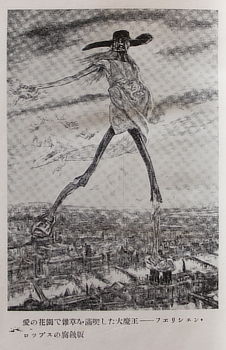

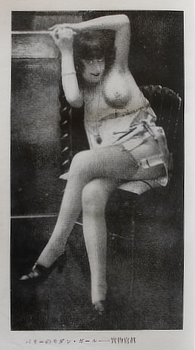

Izumi Keiji [ed]. [Neo Dekameron] Neo Decameron on the cover. Tokyo, Bunshodo 1931 (Showa 6). 18x11cm publisher's decorated cloth blocked in white, printed card slipcase; 49 plates (one colour) from various sources. A nice copy. Au$200
First edition. A pleasing example of the ero-guro-nansu (erotic-grotesque-nonsense) craze of the early showa period. This is a stylish gathering of salacious pieces that would normally appear in pulp magazines. What caught my eye is the piece which sort of translates as 'The Electric Artificial Maiden's Secret Room' which sums up the whole notion of ero-garu-nansu. This jostles with sex murder in the Shanghai British Concession and plenty more. The illustrations are pinched from louche sources, mostly European I'd say.
Neo Decameron it may be but there are 21 stories, not ten. Worldcat finds no copy.


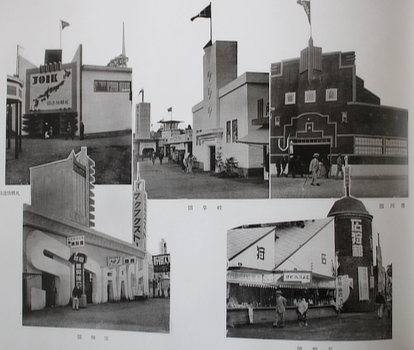
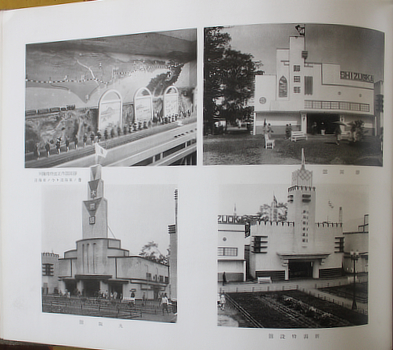

Exposition - Hokkaido 1931. [Kokusan Shinko Hokkaido Takushoku Hakurankai Kinen Shashin Jo]. Hokkaido Takushoku Hakurankai, 1931 (Showa 6). 27x37cm publisher's patterned silk, cord ties (browning around the edges); title page, photo illustrations on 35 leaves of heavy gloss paper, 12 pages of text and a plan. Au$600
A luxurous celebration, with exemplary printing, of the 1931 Hokkaido Colonization Exposition. Had you heard of it before now? Me neither. Thankfully the important old men who always head such books don't take up too much space and it gets more interesting the further we go in. What's wonderful is the number of pavilions that might have come straight out of the pages of the exposition volume of the Gendai Shogyo Bijutsu Zenshu - the Complete Commercial Artist - of 1928-30. Either the same designers were at work or the organisers handed out copies of the book and said, "go for your life."
At the very end we find what seem to have been the big draws for the 600,000 plus visitors: the human cannonball, the world's fattest woman, and dancing girls.
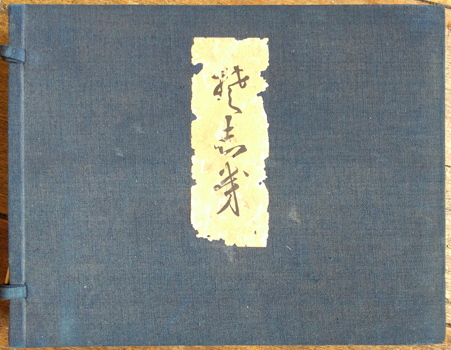
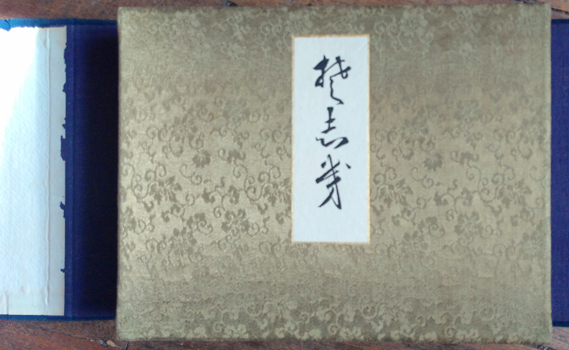
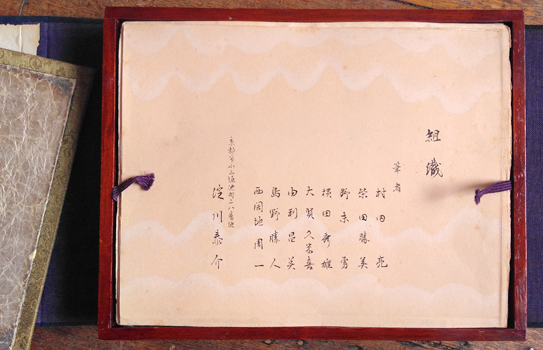
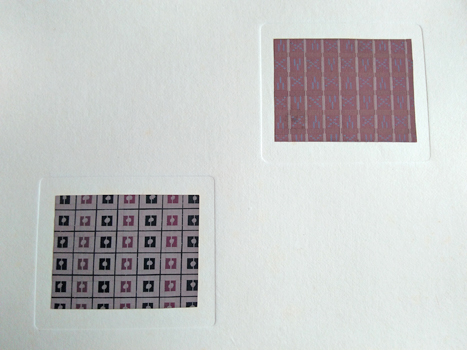

Yodogawa Taisuke. [Suwae Kokorozashi Iku?]. Kyoto, Uchida 1932 (Showa 7). 20x26cm, introductory leaf and 48 leaves, each with two mounted colour designs and tissue guards, card with colophon; loose as issued in wooden box with brocade lid and integral folding cloth case. Title label on the front board nibbled, some spotting or browning of the tissue guards barely affecting the mounts. Au$450
A deluxe, very Kyoto refined, album of textile designs. The introductory leaf indicates that eight artists are responsible for the designs. These designs are not dramatic, they are autumnal and tasteful, beautifully printed, and texture is part of the process.

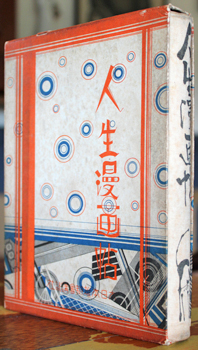
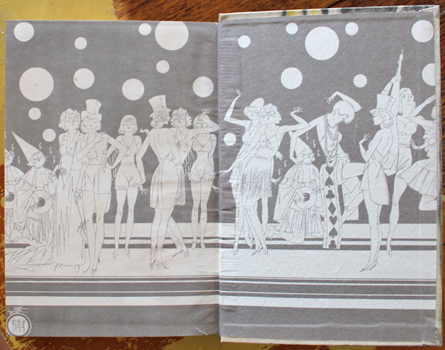
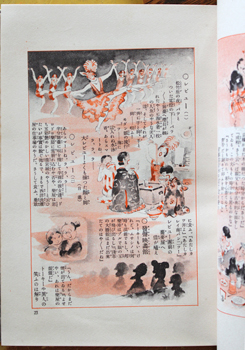

Manga. [Jinsei Mangacho]. Tokyo, Kodansha 1932 (Showa 7). 20x14cm publisher's colour printed cream cloth and colour printed slipcase; 330pp and publisher's advertisements; colour frontispiece. illustrated throughout, the first 32 pages in red and black, the rest in black. Spine a touch browned, edges and case a bit more so; a remarkably good copy of a book born to be a grubby wreck. Au$300
First edition; jazz age manga for grown up kids by a gang of manga stars. The cover, box, endpapers and title page are by Sugita Santaro.
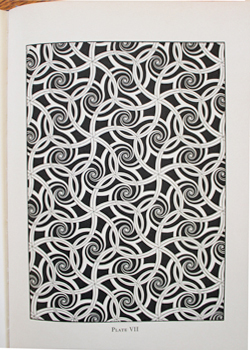
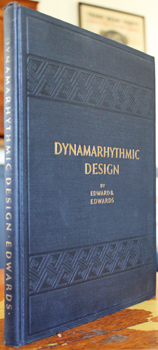
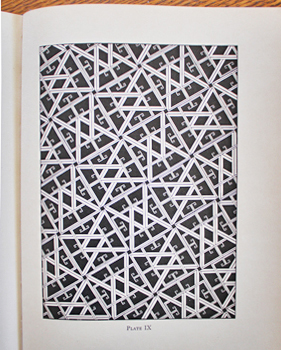
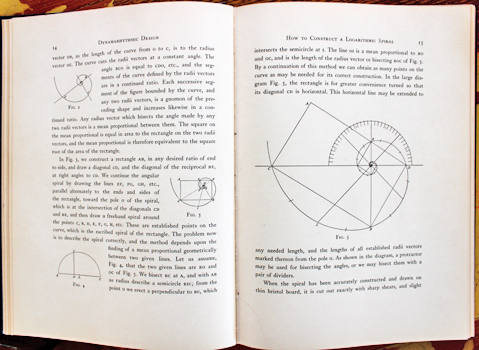

EDWARDS, Edward B. Dynamarhythmic Design. A book of structural pattern. N.Y. Century 1932. Small quarto publisher's cloth; xx,122pp, 28 plates, numerous illustrations through the text. Rather good. Au$300
First edition, not easy to find in good shape. Whatever we think of the theories of Jay Hambidge, drawn from his perceived rediscovery of the Egyptian and Greek system of symmetry, Edwards use of them has produced "one of the most attractive and ingenious studies of geometric ornament [and] one of the few examples of European geometric design to rival Islamic work in complexity" (Durant: Ornament).
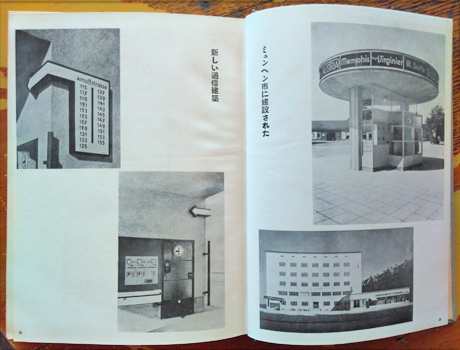
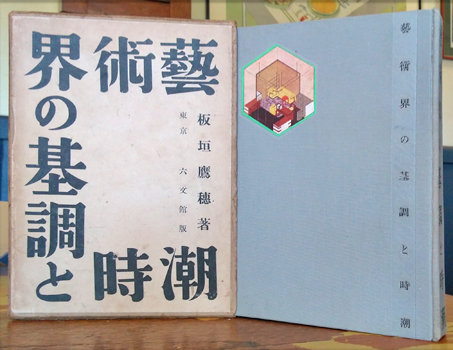
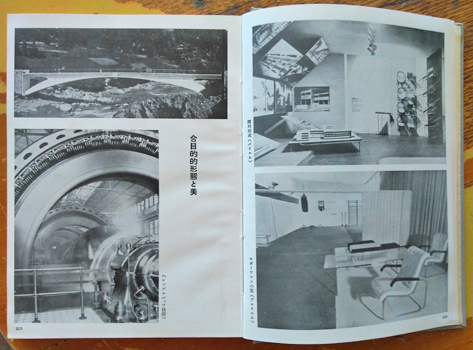
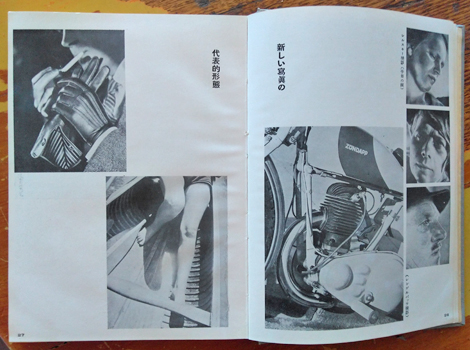

Itagaki Takao. [Geijutsukai no Kicho to Jicho]. Tokyo, Rokubunkan 1932 (Showa 7). 22x16cm, publisher's cloth with onlaid colour illustration, mildly used printed card slipcase; 428pp including 36 pages of photo illustrations. Rather good. Au$650
First edition. Itagaki was seemingly indefatigable as a champion of modernity and modernism in the late twenties and early thirties. Between 1929 and 1933 he worried at the relationship of the machine to art, design, architecture, photography and film, propounding his concept of "machine realism" in a small bundle of books like this. Come the deadly government crackdown on Itagaki's natural disputants - the "proletarian realists" - he apparently retreated into conservative didactic writing on western art and film.

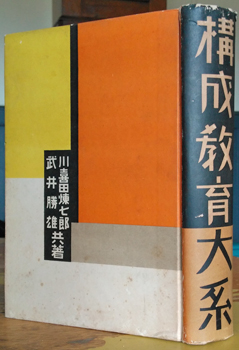
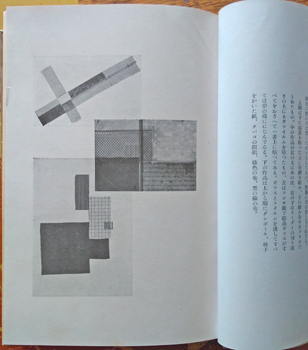
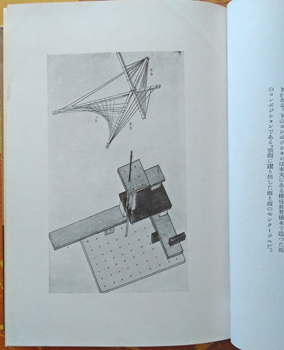

Kawakita Renshichiro & Takei Katso. [Kosei Kyoiku Taikei]. Tokyo, Gakko Bijutsu Kyokai Shuppan-bu 1934 (Showa 9). 22x16cm publisher's colour printed boards (a bit spotted with small surface scrapes at the tips); [2], 12 plates (four colour), 520pp, profusely illustrated throughout. Some spotting around the edge; a rather good copy of a vulnerable book. Au$1650
First edition. A textbook in a way but a remarkable and thoroughly modernist one. Much influenced but, I'm told, not slavishly, by the Bauhaus method of teaching, this education in design or composition contains both the philosophy and practice of Kawakita's Shinkenchiku Kogei Gakuin (School of New Architecture and Design) successor to his Seikatsu Kosei Kenkyusho (Research Institute for Life Configurations).
The book apparently caused some unhappiness among cutting edge architects who complained that it was too abstract but was hugely popular among art teachers. This might explain why the book seems so hard to find: a bunch of black thumbed, paint spattered art students soon puts paid to any book. Worldcat finds only the NDL entry.
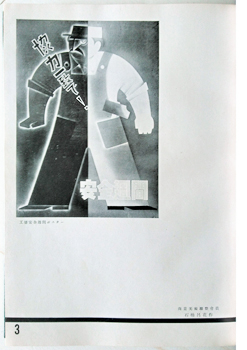
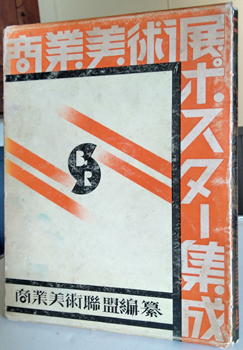
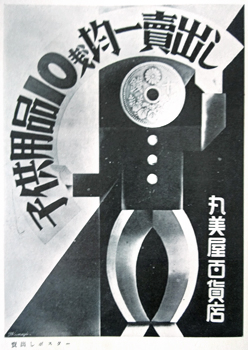


Posters. [Shogyo Bijutsuten Posuta Shusei]. Osaka, Shogyo Bijutsu Renmai 1934 (Showa 9). 27x20cm publisher's patterned boards and slipcase printed in orange and black (this fairly rubbed but solid and presentable enough); [5]ll and 104 b/w plates printed on one side. Au$300
Short on colour maybe but still a good exhibition of modern Japanese poster designs mounted by the Commercial Art League (Shogyo Bijutsu Renmai). Designs - not printed or published posters - with artists all identified. Not such a rare book but hard to find in better than revolting condition.
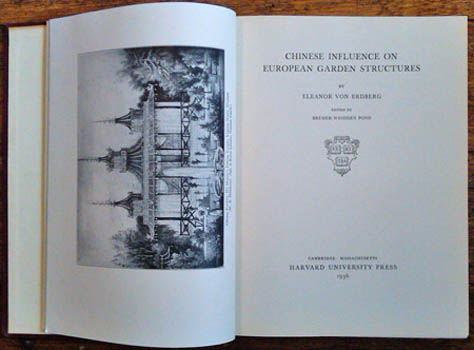
von ERDBERG, Eleanor. Chinese Influence On European Garden Structures. Harvard Univ Press 1936. Quarto publisher's cloth (a touch of wear to spine top); [6],221pp & 95 illustrations. Harvard Landscape Architecture Monographs I. Au$100
A scholarly but none the less interesting study. With an annotated list of the buildings mentioned giving description, bibliography and present condition, if any.
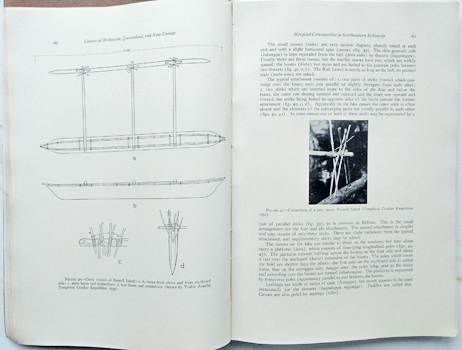
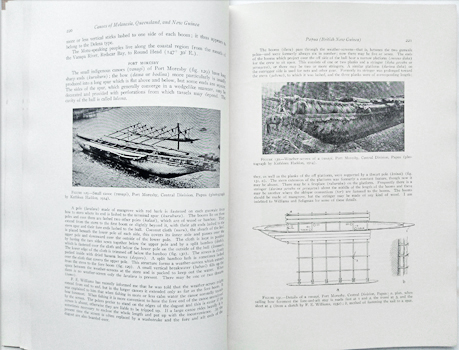
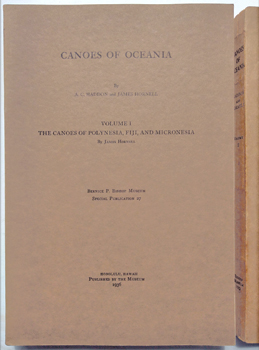
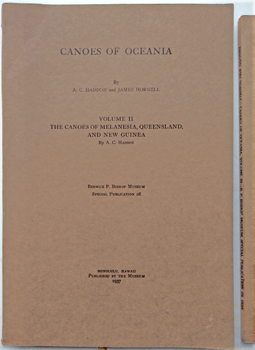

HADDON, A.C. & James HORNELL. Canoes of Oceania. Honolulu, Bishop Museum 1936-37-38. Three volumes large octavo publisher's printed wrappers; numerous photo illustrations and line drawings throughout. An excellent set. Au$1750
Hard to find complete in such good shape, this is the definitive work. I: The Canoes of Polynesia, Fiji, and Micronesia by Hornell; II: The canoes of Melanesia, Queensland by Haddon; III: Definition of Terms, General Survey, and Conclusions by both.
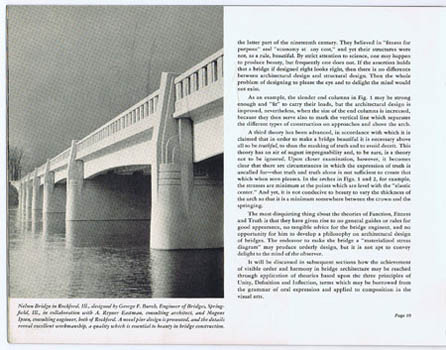
Bridges. Portland Cement Association. Architectural Design of Concrete Bridges. Concrete for permanence. Chicago, Portland Cement [1937]. Oblong quarto publisher's printed wrapper; 36pp, photo and other illustrations throughout. Au$60
'Fundamental principles', that is the rules of design - appearance as separate from structure - are succinctly set out and illustrated by recent modern and moderne bridges. Mistakes are shown and corrected in diagrams.
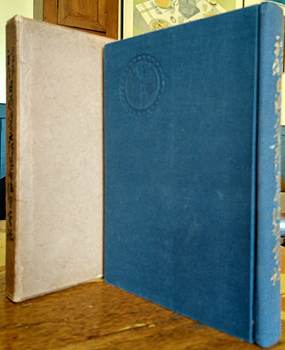
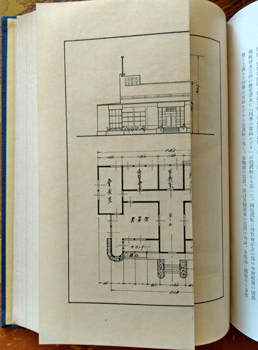
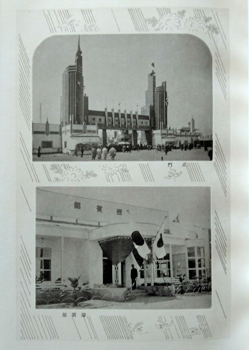
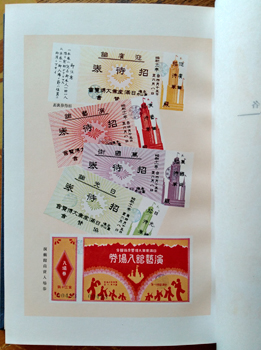

Exhibition - Toyama 1936. [Toyamashi Shusai Nichiman Sangyo Daihakurankai Kyosankai Shi]. Toyama 1938 (Showa 13). 23x16cm publisher's cloth and card box; numerous photo illustrations, colour plates, folding plans and elevations. A nice copy. Au$650
The official report on the 1936 Japan-Manchuria Great Industrial Exhibition. Though blemished by too many portraits of personages, this is still an excellent record of thirties Japanese expo architecture and design with coloured pictures of posters, advertising, tickets and so on, plans and elevations of buildings, lighting, and photo views. There is also the obligatory Hatsusaburo colour folding birds-eye panorama.
Worldcat finds two copies outside Japan, both in California.

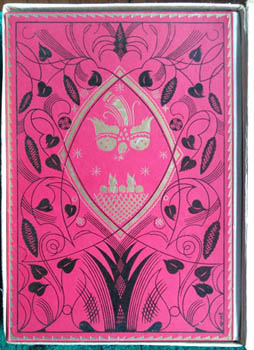
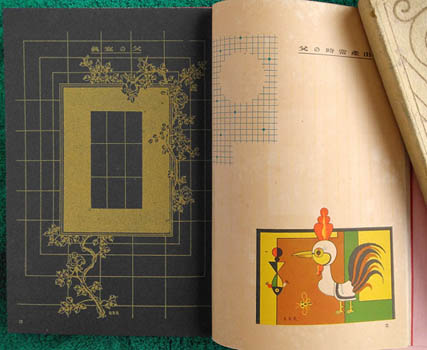


Sugiura Hisui, Takeo Takei, Takeshi Kimata &c. [Wagako no Rekishi]. Osaka, Mitsokushi [1939] (Showa 14). 27x19cm publisher's cloth backed boards decorated in gilt and black in mildy worn decorated box; 84pp illustrated in colour throughout by Takei and others; cover design by Sigiura. Partly filled in with pencil, two chubby hands have been traced in ink; occasional browning or offsetting; a remarkably good copy. Au$300
This book was child of the Mitsokushi department store, first published in 1928, reprinted fairly often and presumably updated. One of Takei's illustrations is dated 1934. Who was the titan that came up this genius innovation - the predigested baby album? Does he or she have a shrine in the marketing hall of fame? They - books like this - seem to have popped up round the world in the twenties - were they earlier? This has one foot planted in revoltingly cute of course but, thanks to Takei and a couple of fellow artists, enough pages keep the other foot in stylish and exciting.
Worldcat finds one copy - a 1938 edition at Princeton - and NDL finds two - 1928 and 1936 editions - in Japanese libraries. While doing homework on this I came across a poor - so to speak - descendant, the Blot. For a mere 20,000 yen you get something that looks suspiciously like a leather filofax - if you're old enough to remember the filofax - no cute pictures, no revolting sentiment. Poor kids.

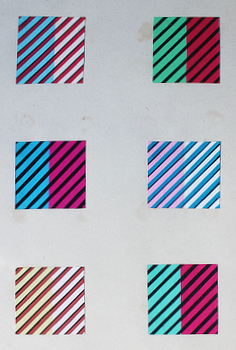
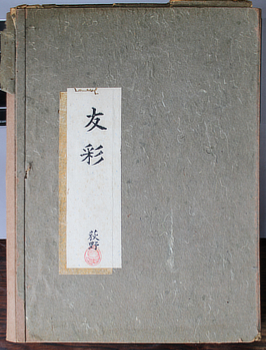
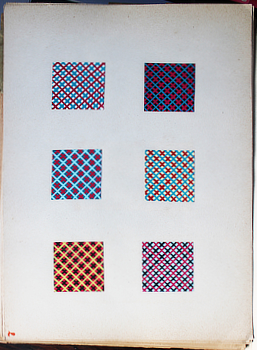

Ogino Masao & Tsuboi Motoyoshi [Yusai]. Tokyo, Ogino & Tsuboi? 1943 (Showa 18). 32x24cm, loose as issued publisher's folding card case (bottom flap missing, top ragged along the fold), printed paper label over a gold label. Title page and 28 numbered leaves with 126 mounted colour designs. Title browned, a little browning of the mounting leaves. Au$1850
Beautifully printed and mysterious; what more can anyone ask of a colour book? The colour printing is crisp, saturated and vivid. Yusai translates literally as 'friend colour' - a glazing technique using colours is called yusai - but what it really means other than colours friendly to each other I don't know. Neither do I know who Ogino and Tsuboi are. Ogino's name and seal is on the title slip, both names are on the title page and the colophon slip pasted inside the back cover. Beyond this is mystery.
How and why was something like this produced in 1943? A kimono pattern book out of Kyoto or Osaka is one thing but this is a colour grammar out of Tokyo. Textile patterns are used but the designs are secondary. Two names, two Tokyo addresses, and the year are all the information we have.
I can find no mention it exists.
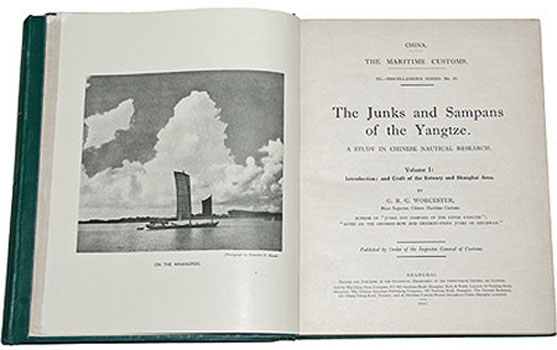


WORCESTER, G.R.G. [George Raleigh Gray]. The Junks and Sampans of the Yangtze. A study in Chinese nautical research. Shanghai, Dept of Customs 1947-48. Two volumes quarto publisher's green cloth (different grained cloth on each volume); numerous photo illustrations, measured drawings & plans, several folding. A nice, bright pair. Au$1600
Worcester was by no means the only civil servant in China, or any exotic foreign spot, to devote large slabs of their life to collecting, collating and preserving disappearing arts, crafts, languages and customs, but his books on junks and sampans are remarkable for being exhaustive and well timed. They are references that can never be obsolete, recording as they do dozens of now vanished vessel types - their design, construction, peculiar use and all manner of social and personal history of their owners and crews.
  1 2 [3] 4 1 2 [3] 4   |